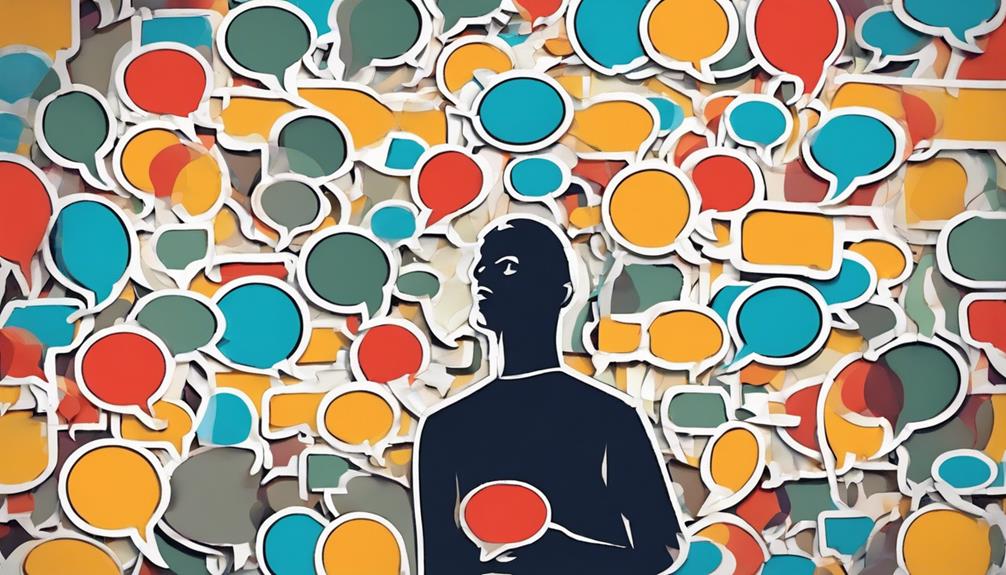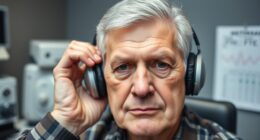Living with deafness means navigating a world where silence can be both comforting and challenging. Whether enjoying the solitude or feeling excluded, every aspect of daily life carries its own importance.
The challenges faced by deaf individuals extend beyond communication barriers, touching upon safety, education, employment, and mental well-being. As we explore the complexities of this experience, we invite you to consider the resilience and strength that shines through in the face of adversity.
Key Takeaways
- Communication barriers and discrimination impact daily life.
- Deaf individuals face educational and employment challenges.
- Social interactions require unique communication strategies.
- Advocacy for deaf rights and inclusion is crucial for equality.
Daily Communication Challenges
Navigating daily communication as a deaf individual presents a myriad of intricate challenges that profoundly impact our interactions and relationships.
The limitations of lip reading, which is only about 30% accurate, make it difficult for us to fully grasp conversations. Additionally, the fact that there are over 300 different sign languages worldwide adds another layer of complexity to our communication efforts.
Many of us prefer texting or messaging over phone calls due to the constraints of traditional auditory communication. Misunderstandings in communication can lead to social isolation, further complicating our daily interactions and relationships.
However, assistive technologies such as hearing aids and cochlear implants play a crucial role in bridging these communication gaps for deaf individuals, offering us a means to connect with the world around us in a more effective manner.
Despite these challenges, we strive to overcome them and foster meaningful connections in our lives.
Feeling Isolated in a Noisy World

In the midst of our daily communication challenges, the overwhelming feeling of isolation in a noisy world weighs heavily on deaf individuals. Hearing or hard of hearing people often find themselves struggling in social situations, especially in noisy environments where background clamor drowns out meaningful conversations. The constant battle to decipher speech amidst the chaos of crowded places like restaurants or events can lead to a profound sense of exclusion and loneliness.
Imagine being surrounded by people chatting and laughing, yet feeling entirely detached from the interaction, unable to catch the nuances of the dialogue. For many deaf individuals, this isn't just a scenario but a harsh reality they face regularly. The frustration of not being able to fully participate in conversations due to noisy environments can create barriers to social inclusion and deepen the feelings of isolation.
As we strive to understand the challenges faced by deaf individuals in noisy settings, let's work towards creating more inclusive and accommodating environments where everyone, regardless of their hearing abilities, can feel connected and valued.
Navigating Social Situations as a Deaf Person
Navigating social situations as a deaf person can be incredibly challenging.
We often struggle to pick up on social cues, leading to misunderstandings and frustrations.
Developing effective communication strategies and fostering patience and understanding are crucial in overcoming these obstacles.
Social Cues Challenges
Social interactions pose unique challenges for deaf individuals, as they often struggle to interpret auditory social cues essential for effective communication. Deaf individuals rely heavily on visual cues, body language, and facial expressions to navigate social situations. Understanding nuances like sarcasm, humor, and subtle emotional cues can be particularly challenging, leading to feelings of isolation in group conversations where multiple speakers and overlapping dialogues can be overwhelming.
Coping with social anxiety and the fear of being left out are common experiences for deaf individuals. Despite these obstacles, deaf individuals demonstrate resilience and adaptability, finding ways to connect with others through different means. It's essential for society to be more understanding and inclusive, helping to bridge the communication gap and create a more accessible environment for all.
Communication Strategies
Understanding the intricacies of effective communication as a deaf individual involves employing various strategies to navigate social situations with clarity and connection. Deaf individuals often rely on visual cues, facial expressions, and body language to understand conversations. Strategies like lip-reading, sign language, and technology such as speech-to-text apps play crucial roles in facilitating communication. In group settings, seating arrangements that allow for clear visibility can enhance interactions. Respecting the communication preferences of deaf individuals is key to fostering positive relationships. By embracing these communication strategies, we create inclusive environments where everyone can engage meaningfully.
| Communication Strategies | Examples |
|---|---|
| Visual cues | Facial expressions, body language |
| Lip-reading | Seating for clear visibility |
| Sign language | ASL, BSL |
| Technology | Speech-to-text apps, video relay services |
Misunderstandings and Frustrations
In our daily interactions, misunderstandings and frustrations can often arise for deaf individuals due to the communication barriers they encounter. Navigating social situations as a deaf person can be challenging, especially when effective communication methods aren't utilized. We rely heavily on visual cues and written communication to understand and participate fully.
Lack of awareness about deaf culture and communication needs can lead to misconceptions and frustrations in social settings. It's crucial for others to understand the importance of clear speech, facing us when talking, and being patient to avoid misunderstandings. By being mindful of these communication strategies, we can foster more inclusive and understanding social environments for deaf individuals.
Impact of Hearing Loss on Mental Health

Deaf individuals face significant mental health challenges due to the impact of hearing loss on their daily lives.
We understand the struggles they endure, from battling feelings of isolation and loneliness to coping with limited access to mental health services.
Our community must come together to support and uplift deaf individuals in their journey towards better mental well-being.
Mental Health Challenges
How can the impact of hearing loss on mental health be effectively addressed in the deaf community?
Deaf individuals face higher risks of depression and anxiety due to communication barriers and limited access to mental health services. To tackle these challenges, we must prioritize the mental well-being of the deaf community. Here are some key steps to consider:
- Increasing Accessibility: Improving access to mental health services tailored to the needs of deaf individuals.
- Enhancing Communication: Promoting effective communication strategies to reduce feelings of isolation and loneliness.
- Combatting Discrimination: Addressing negative interactions and discrimination to create a supportive environment.
- Building Support Networks: Encouraging peer and community support to foster mental wellness among deaf individuals.
Coping Strategies
To effectively cope with the impact of hearing loss on mental health, it's crucial for the deaf community to develop personalized strategies that address their unique challenges and promote resilience. Deaf individuals often face communication barriers that can lead to feelings of isolation and loneliness, increasing the risk of depression and anxiety. Limited access to mental health services further exacerbates these issues.
Social support from peers and the community plays a vital role in maintaining the mental well-being of deaf individuals. Additionally, addressing mental health stigma within the deaf community is essential for promoting awareness and support. By recognizing these challenges and actively seeking out coping mechanisms, deaf individuals can work towards improving their mental health and overall quality of life.
Accessibility Barriers in Society

Navigating through public spaces can be a challenging ordeal for individuals who are deaf, as accessibility barriers often hinder their seamless interaction with the environment. Deaf individuals encounter numerous obstacles that impede their ability to fully engage with society:
- Lack of Visual or Tactile Cues: Public spaces often lack visual or tactile cues that are essential for deaf individuals to navigate safely and independently.
- Inaccessible Information: Important public announcements, emergency alerts, and informational content are frequently inaccessible to deaf individuals, depriving them of crucial information.
- Limited Sign Language Interpreters: The scarcity of sign language interpreters in essential services creates significant communication barriers for deaf people, hindering their access to vital services.
- Inadequate Captioning and Subtitles: Media content with insufficient captioning and subtitles poses challenges for the deaf community, limiting their ability to access and enjoy various forms of entertainment and information.
Overcoming Stereotypes and Misconceptions

As deaf individuals, we understand the uphill battle of challenging stereotypes and dispelling misconceptions about our capabilities.
It's disheartening when society underestimates us due to our deafness, hindering our potential for success.
Challenging Stereotypes
Challenging stereotypes that label deaf individuals as unintelligent or incapable due to their hearing loss is a crucial step towards promoting understanding and inclusivity in society.
It's hard when people make assumptions based on stereotypes, hindering opportunities for deaf individuals and perpetuating misconceptions.
To challenge these stereotypes effectively, we must educate others on the abilities and strengths of deaf individuals. This involves showcasing the diverse talents within the deaf community and advocating for equal opportunities in education, employment, and social interactions.
Dispelling Misconceptions
In debunking misconceptions surrounding deaf individuals, we illuminate the diverse capabilities and strengths they possess, fostering a more inclusive and understanding society. It's essential to recognize that deafness doesn't define one's potential or limit their contributions.
Misconceptions portraying deaf individuals as helpless overlook their resilience and talents. Many deaf individuals excel in various fields, showcasing their abilities and debunking the myth of limitations.
Discrimination stemming from misconceptions can hinder opportunities in education, employment, and social interactions. By understanding and appreciating the capabilities of deaf individuals, we can create an inclusive environment where everyone is valued for their unique skills and perspectives.
Let's work together to break down barriers and build a society that embraces diversity wholeheartedly.
Coping With the Frustration of Miscommunication

Navigating the frustrations of miscommunication as a deaf person can be an ongoing battle that impacts every aspect of daily life. Here are some key challenges faced by deaf individuals in coping with the frustration of miscommunication:
- Isolation: Miscommunication can lead to feelings of isolation as deaf individuals struggle to fully engage in conversations and social interactions.
- Frustration: The constant misunderstandings and communication breakdowns due to the inability to pick up on verbal cues can be incredibly frustrating for deaf individuals.
- Missed Nuances: Deaf people often miss out on subtle verbal cues like tone of voice or background noises, making it challenging to grasp the full context of a conversation.
- Difficulty in Group Settings: Following multiple speakers in group conversations can be overwhelming for deaf individuals, leading to a sense of exclusion and disconnect.
Coping with these daily challenges can take a toll on the emotional well-being of deaf individuals, highlighting the importance of understanding and accommodating their communication needs.
Advocating for Deaf Rights and Inclusion

Advocating for Deaf Rights and Inclusion is crucial for fostering a society that values accessibility and equality for all individuals, regardless of their hearing abilities. Deaf rights are human rights, and it's essential to ensure that deaf individuals have equal opportunities and access to accommodations in various aspects of life. Organizations like the National Association of the Deaf (NAD) play a vital role in promoting deaf rights and advocating for increased accessibility.
The Americans with Disabilities Act (ADA) serves as a crucial legal framework that protects deaf individuals in areas such as employment and public accommodations. Captioning laws further enforce the provision of captions for television programs and public events, enhancing accessibility for deaf viewers. Deaf individuals have the right to request accommodations under the ADA, emphasizing the importance of creating inclusive environments.
Continued advocacy efforts are necessary to break down barriers and create a society where deaf individuals can fully participate and thrive. By championing deaf rights and inclusion, we contribute to a more equitable and accessible world for all.
Balancing Identity in Both Hearing and Deaf Worlds

Balancing identities between the hearing and Deaf worlds presents a unique challenge for individuals who are deaf. This delicate balance can often lead to feelings of social anxiety and adjustment issues as they navigate different social norms and expectations. The fear of missing out on social situations in both the hearing and Deaf communities is a common struggle, impacting their sense of belonging and acceptance.
- Overcoming Social Anxiety: Deaf individuals may face disabling anxiety in group settings, making it challenging to fully engage and participate in social interactions.
- Navigating Cultural Differences: Straddling both worlds requires constant adaptation and understanding of diverse cultural norms and communication styles.
- Embracing American Sign Language (ASL): Improving ASL skills is crucial for effective communication, yet the pressure to excel in this language can sometimes be overwhelming, hindering self-expression and emotional well-being.
- Seeking Balance and Acceptance: Finding a harmonious balance between the hearing and Deaf worlds is an ongoing journey that requires patience, self-compassion, and a supportive community.
Celebrating Resilience and Strength

Deaf individuals embody an inspiring resilience that empowers them to triumph over daily obstacles with unwavering strength and determination. In the face of communication barriers and societal challenges, deaf people exhibit remarkable perseverance, demonstrating their ability to navigate a predominantly hearing world with grace and fortitude. Their strength and adaptability shine through as they tackle educational, employment, and social hurdles, showcasing strong problem-solving skills and a deep sense of cultural pride.
Celebrating the unique strengths of deaf individuals, we recognize their heightened visual awareness and enhanced communication skills as valuable assets that enrich not only their own lives but also the communities they're a part of. The hard life of a deaf person is a testament to their resilience and unwavering spirit, inspiring us all to approach life's challenges with a similar determination and grace. By acknowledging and honoring the strength and perseverance of deaf individuals, we can learn valuable lessons in overcoming adversity and embracing diversity.
Frequently Asked Questions
How Is the Life of a Deaf Person?
Life as a deaf person presents unique challenges. We face daily obstacles due to missed auditory cues and communication barriers. Safety risks rise as we may not hear warnings or sirens. Simple tasks become intricate, like navigating low-light environments.
Everyday conversations can be tough, requiring clear communication methods. Despite these challenges, we strive to overcome obstacles, advocating for accessibility and understanding in a hearing-centric world.
What Are the Struggles of Deaf People?
We understand the struggles of deaf individuals in daily life. Communication barriers can lead to missed cues, safety risks, and feelings of isolation.
In various settings like driving or public places, challenges arise due to the inability to hear. This can create startle responses and contribute to mental health issues like depression and anxiety.
Deaf individuals often feel discriminated against and may withdraw from social interactions, highlighting the need for increased understanding and support.
How Does Being Deaf Affect Your Life?
Being deaf impacts our lives in profound ways. Communication challenges and safety concerns are ever-present. We often feel isolated and vulnerable in public settings. Education and job opportunities are limited due to these barriers.
Depression and anxiety rates are higher among us, stemming from social isolation and communication difficulties. Everyday interactions can be challenging, affecting our overall well-being.
The impact of being deaf is far-reaching and shapes our daily experiences.
What Is One of the Rudest Things You Can Do to a Deaf Person?
Ignoring a deaf person when they want to communicate is one of the rudest things you can do. It's crucial to provide accommodations like visual aids or sign language to show respect.
Speaking condescendingly or interrupting a deaf person is highly impolite. Making assumptions about their abilities without letting them communicate effectively is dismissive.
Let's strive to be more considerate and inclusive in our interactions with deaf individuals.
Conclusion
In the midst of our struggles, we stand united as a deaf community, resilient and strong. Our experiences may be challenging, but they've shaped us into warriors of perseverance.
Let's not be defined by our limitations, but by our unwavering determination to thrive despite the odds. Together, we amplify our voices and advocate for our rights, paving the way for a more inclusive and understanding world.
Join us in our journey of empowerment, as we continue to break barriers and shine brightly in the face of adversity.











